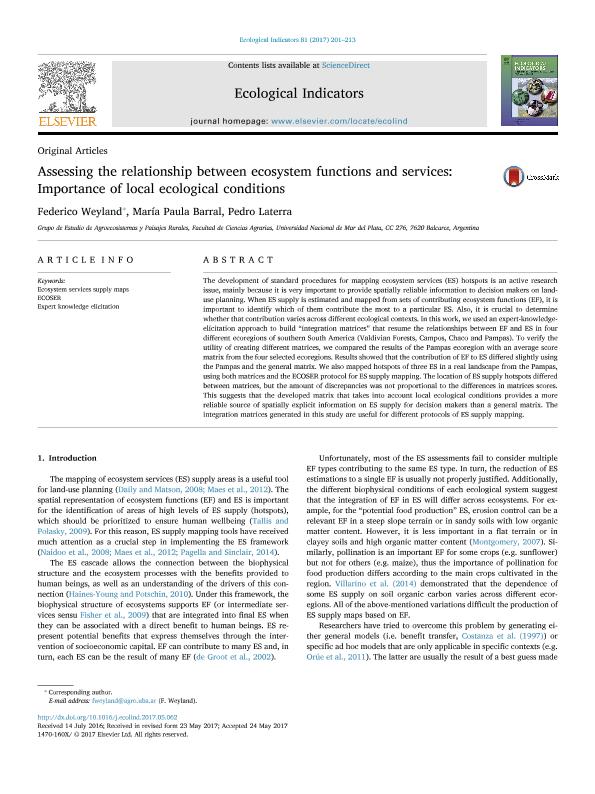Mostrar el registro sencillo del ítem
dc.contributor.author
Weyland, Federico

dc.contributor.author
Barral, María Paula

dc.contributor.author
Laterra, Pedro

dc.date.available
2018-08-14T15:17:43Z
dc.date.issued
2017-10
dc.identifier.citation
Weyland, Federico; Barral, María Paula; Laterra, Pedro; Assessing the relationship between ecosystem functions and services: Importance of local ecological conditions; Elsevier Science; Ecological Indicators; 81; 10-2017; 201-213
dc.identifier.issn
1470-160X
dc.identifier.uri
http://hdl.handle.net/11336/55352
dc.description.abstract
The development of standard procedures for mapping ecosystem services (ES) hotspots is an active research issue, mainly because it is very important to provide spatially reliable information to decision makers on land-use planning. When ES supply is estimated and mapped from sets of contributing ecosystem functions (EF), it is important to identify which of them contribute the most to a particular ES. Also, it is crucial to determine whether that contribution varies across different ecological contexts. In this work, we used an expert-knowledge-elicitation approach to build “integration matrices” that resume the relationships between EF and ES in four different ecoregions of southern South America (Valdivian Forests, Campos, Chaco and Pampas). To verify the utility of creating different matrices, we compared the results of the Pampas ecoregion with an average score matrix from the four selected ecoregions. Results showed that the contribution of EF to ES differed slightly using the Pampas and the general matrix. We also mapped hotspots of three ES in a real landscape from the Pampas, using both matrices and the ECOSER protocol for ES supply mapping. The location of ES supply hotspots differed between matrices, but the amount of discrepancies was not proportional to the differences in matrices scores. This suggests that the developed matrix that takes into account local ecological conditions provides a more reliable source of spatially explicit information on ES supply for decision makers than a general matrix. The integration matrices generated in this study are useful for different protocols of ES supply mapping.
dc.format
application/pdf
dc.language.iso
eng
dc.publisher
Elsevier Science

dc.rights
info:eu-repo/semantics/openAccess
dc.rights.uri
https://creativecommons.org/licenses/by-nc-nd/2.5/ar/
dc.subject
Ecoser
dc.subject
Ecosystem Services Supply Maps
dc.subject
Expert Knowledge Elicitation
dc.subject.classification
Otras Ciencias Biológicas

dc.subject.classification
Ciencias Biológicas

dc.subject.classification
CIENCIAS NATURALES Y EXACTAS

dc.title
Assessing the relationship between ecosystem functions and services: Importance of local ecological conditions
dc.type
info:eu-repo/semantics/article
dc.type
info:ar-repo/semantics/artículo
dc.type
info:eu-repo/semantics/publishedVersion
dc.date.updated
2018-08-13T17:23:07Z
dc.journal.volume
81
dc.journal.pagination
201-213
dc.journal.pais
Países Bajos

dc.journal.ciudad
Amsterdam
dc.description.fil
Fil: Weyland, Federico. Consejo Nacional de Investigaciones Científicas y Técnicas; Argentina. Universidad Nacional de Mar del Plata. Facultad de Ciencias Agrarias; Argentina
dc.description.fil
Fil: Barral, María Paula. Universidad Nacional de Mar del Plata. Facultad de Ciencias Agrarias; Argentina. Consejo Nacional de Investigaciones Científicas y Técnicas; Argentina
dc.description.fil
Fil: Laterra, Pedro. Universidad Nacional de Mar del Plata. Facultad de Ciencias Agrarias; Argentina. Consejo Nacional de Investigaciones Científicas y Técnicas; Argentina
dc.journal.title
Ecological Indicators

dc.relation.alternativeid
info:eu-repo/semantics/altIdentifier/doi/http://dx.doi.org/10.1016/j.ecolind.2017.05.062
dc.relation.alternativeid
info:eu-repo/semantics/altIdentifier/url/https://www.sciencedirect.com/science/article/pii/S1470160X17303175
Archivos asociados
